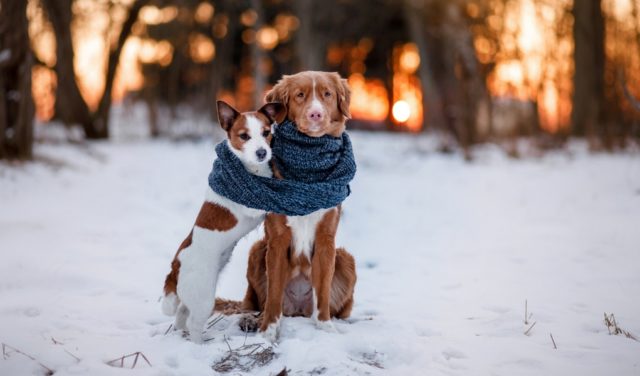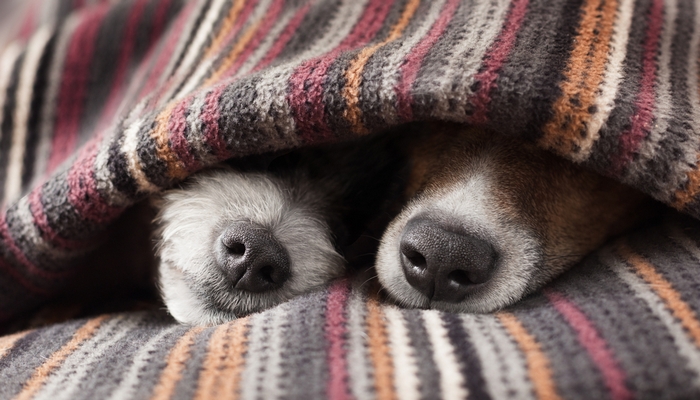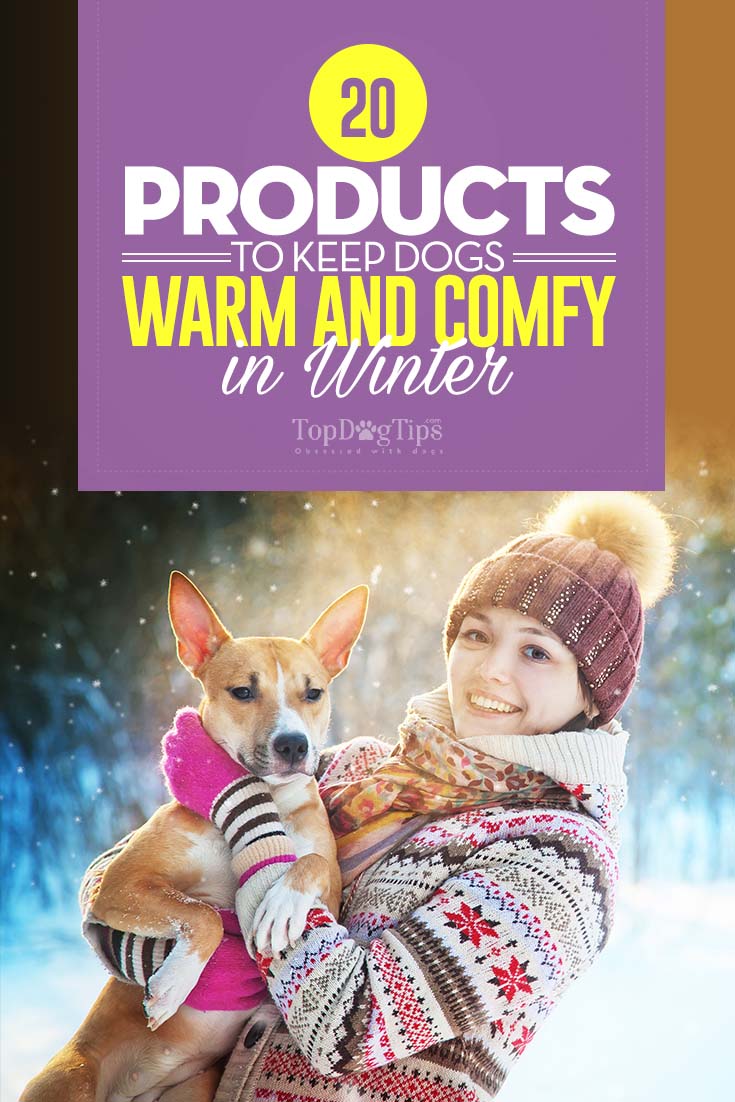
Table of Contents
- 20 Things to Keep Dogs Warm in Winter
- 1. Sweaters
- 2. Jackets, Vests
- 3. Dog Boots
- 4. Snowsuits
- 5. Snoods
- 6. Heating Pads
- 7. Heated Dog Beds
- 8. Heated Dog Toys
- 9. Thick Blanket
- 10. Raised Dog Beds
- 11. Draft Protectors
- 12. Paw Protection
- 13. Warming Dog Harnesses
- 14. Indoor Potty Patches
- 15. Warming Car Hammocks
- 16. Warming Sofa Covers
- 17. Heated Dog Bowls
- 18. Covered Beds
- 19. Pajamas
- 20. Dog Umbrellas
Whether your dog only goes outside for short walks or spends hours outdoors in the cold weather, there are some things to keep dogs warm in winter for their own safety.
Some dog winter clothes can be a life savior for some breeds especially.
Even northern breeds with thick double coats can get chilled in winter weather.
This means that once temperatures drop to unsafe levels, you'll need to take precautions to keep your dog warm.
Veterinarians also encourage the use of sweaters/jackets and shoes.
The precautions that you take will need to be based on your dog's individual needs.
All the things that are available to keep dogs warm in winter vary from thick warm doggy jackets to snow booties.
While your pet's natural fur coat may be enough to keep their body warm, sometimes their paws require protection from the ice, snow, and chemicals.

20 Things to Keep Dogs Warm in Winter
1. Sweaters
Dog sweaters come in many different shapes, sizes, thicknesses, and prints, and they are one of the greatest things to keep dogs warm in winter. Not all dogs require a sweater in the winter, but they can be useful for some breeds, including:
- hairless breeds
- short-haired dogs
- very young dogs
- very small dogs
- very old dogs
- dogs with an illness
- dogs undergoing serious illness treatment
- dogs with a compromised immune function
All of these dogs require a little help to pull heat close to the body to keep them warm and avoid illness.
2. Jackets, Vests
 Where sweaters are a good way to keep dogs warm indoors or outdoors in the warmer winter weather, jackets are better for those really cold days. Jackets have a higher level of insulation, and some (rarely) are waterproof. Whether it’s raining or snowing, your pet's jacket should ideally keep the dog dry. For warmer rainy days, use a dog raincoat instead.
Where sweaters are a good way to keep dogs warm indoors or outdoors in the warmer winter weather, jackets are better for those really cold days. Jackets have a higher level of insulation, and some (rarely) are waterproof. Whether it’s raining or snowing, your pet's jacket should ideally keep the dog dry. For warmer rainy days, use a dog raincoat instead.
Some jackets and vests are sold with hoods or other “attachments,” but the most practical is a simple dog jacket that covers the animal's body but allows freedom to potty as well. One of our favorite lines of outerwear is from Gooby and Ruffwear.
3. Dog Boots
Dog shoes protect your dog’s feet from sharp ice, hidden dangers in the snow, and de-icing chemicals that are toxic to pets. These things to keep dogs warm in winter also keep your pup’s feet toasty by insulating them and preventing the hair and skin between paw pads from getting cold and wet.
There are a lot of variations of dog boots available, but some are specifically for winter. When shopping for winter dog boots, look for “grippable” rubber soles for extra traction (like Ruffwear's “Grip Trex”) and some interior insulation for freezing weather. It is also helpful to have a waterproof exterior to keep the dog's feet dry.
4. Snowsuits
Snowsuits are generally not a practical solution in the cold, and it's rare that you would need them, aside from very extreme weather conditions. Some instances where a dog snowsuit can be useful:
- dogs that live in exceptionally cold climates
- dogs that are completely hairless
- dogs with smaller frames or very low body mass
- dogs with a compromised immune system
Keep in mind that snowsuits can be very arduous to put on and take off, so if they have no real benefit for your dog over a thick jacket, opt for the jacket. They make our list of things to keep dogs warm in winter because they can be useful, but sometimes, there is an easier solution to help your pooch.
5. Snoods
 A snood is like a knitted tube that covers a dog from behind its ears to the bottom of its neck. Snoods are most commonly seen on greyhounds and other dogs with long necks. They are used to keep this thin and muscular area of the body warm.
A snood is like a knitted tube that covers a dog from behind its ears to the bottom of its neck. Snoods are most commonly seen on greyhounds and other dogs with long necks. They are used to keep this thin and muscular area of the body warm.
Snoods are just one piece of winter dog clothing necessary for short hair, thin dog breeds like Greyhounds because their bodies have extremely low body fat and not enough coat fur to insulate the body enough.
6. Heating Pads
Dog heating pads are a great way to keep dogs warm inside the house (yours or in a dog house) during winter. These pads can be self-warming or heated, but they are made to be safe for dogs to lie on.
Heating pads for dogs are particularly useful for elderly dogs or dogs with illnesses that make it hard to maintain body temperature. The pad provides a steady source of warmth when the body cannot, helps with muscle and injury recovery, improves blood circulation, and is vet-recommended for arthritic dogs.
7. Heated Dog Beds
Heated dog beds work much the same way as heated pads do, but they have the heated pad built directly into the bed. Most often, these beds are self-heating, meaning they are built from materials that warm when activated by pressure.
If you're looking for simple things to keep dogs warm in the winter, this is a very easy option. Heated beds, also known as dog bed warmers, are appreciated by most dogs in the colder months, but they can be expensive.
8. Heated Dog Toys
It may surprise you to see heated toys on our list of things to keep dogs warm in winter. For some dogs, particularly those with thick coats, heated beds and heating pads can be too much. These dogs may, however, appreciate a heated toy for a little more warmth.
Heated toys usually contain a reheatable pad that can be warmed in the microwave. This pad is then placed inside a toy to provide warmth without being too hot to the touch. These toys can also be beneficial in comforting anxious dogs and new puppies by imitating another living body.
9. Thick Blanket
 Thick dog blankets are a practical and easy source of warmth for dogs. Adding a few extra blankets on your dog's bed allows them to snuggle or burrow to keep warm. Make sure to wash your dog’s blankets regularly during the winter to prevent dust and dander buildup. Winter allergies are particularly common and can result from dust mites and dander.
Thick dog blankets are a practical and easy source of warmth for dogs. Adding a few extra blankets on your dog's bed allows them to snuggle or burrow to keep warm. Make sure to wash your dog’s blankets regularly during the winter to prevent dust and dander buildup. Winter allergies are particularly common and can result from dust mites and dander.
10. Raised Dog Beds
Raised beds keep your dog lifted off the floor and out of drafts, which makes them ideal for winter. Raised beds have the added benefit of airflow around the bed, which helps keep odors to a minimum.
These elevated dog beds also keep a cushion of air under your dog so that their joints are not lying directly on the hard floor. This makes raised beds a great choice for senior and arthritic dogs, too.
11. Draft Protectors
Drafts slip under doors and through poorly insulated windows and can give you and your dog a chill. While it’s best to improve insulation, draft protectors are a cheaper solution to stopping cold breezes. Draft protectors can be hard to find, but they are always available through Amazon or you can make your own with fabric and dry rice or beans.
12. Paw Protection
 Not all dogs are comfortable wearing boots, but paw protection is still important for keeping paws (and, subsequently, the whole body) warm. Next to booties, the second most often used type of paw protection is paw wax. For example, Musher’s Secret is our favorite brand and one that is used frequently by mushers on their sled dogs.
Not all dogs are comfortable wearing boots, but paw protection is still important for keeping paws (and, subsequently, the whole body) warm. Next to booties, the second most often used type of paw protection is paw wax. For example, Musher’s Secret is our favorite brand and one that is used frequently by mushers on their sled dogs.
Paw waxes (and some paw balms) protect the surface of the paw by putting a protective layer between the paw pad and the ground. This stops de-icing chemicals from damaging paws, but it also keeps paws warm by preventing snow and ice from sticking to paw pads.
13. Warming Dog Harnesses
Warming harnesses are a newer product on the market. These harnesses fit like any other harness, but they have a pocket on the underside that holds a reheatable pad. The pad is heated in the microwave and slips into the harness, providing warmth against the chest.
Warming dog harnesses are good for pets that don’t fit well in traditional jackets but need additional warmth. They are also ideal for providing warmth without the bulk of clothing that can often be burdensome. An additional benefit of warming harnesses is that they are affordable, and they can often be used for cooling as well.
14. Indoor Potty Patches
 Not every dog owner likes the idea of potty patches, but for dog owners who live in particularly harsh environments, they can be a good investment. Potty patches are an indoor tray with faux grass on top. The grass encourages your dog to go to the bathroom on the patch, and the tray underneath collects urine.
Not every dog owner likes the idea of potty patches, but for dog owners who live in particularly harsh environments, they can be a good investment. Potty patches are an indoor tray with faux grass on top. The grass encourages your dog to go to the bathroom on the patch, and the tray underneath collects urine.
Potty patches must be cleaned regularly and can be an odorous problem if not maintained. They can be a good solution for dogs living in states with exceptionally rough winters or dogs living in high-rise apartments.
If you do use a potty patch to help your dog stay warm in the winter, it’s best to keep it in a utility room or even on a balcony where you can windproof your dog’s potty area. Some dog guardians make their own potty patches using real turf and plastic wading pools or Tupperware containers.
15. Warming Car Hammocks
Warming hammocks are another relatively new product. A large piece of fabric that fits over the back seat of the car and the back of the front seats, the hammock serves to keep your dog in place when traveling.
Most car seat hammocks are not heated; they simply act as a barrier and keep seats clean. Heated hammocks, however, offer a heated surface so your dog stays warm on those cold winter mornings.
16. Warming Sofa Covers
Are you noticing a trend? Many of the things to keep dogs warm in winter have a heating element, which you could have certainly figured out on your own. However, you may not have realized that you can purchase warming sofa covers to help your pup.
Similar to warming hammocks, warming sofa covers have the same purpose but are designed to fit over sofa seats. While traditional sofa covers are quite affordable, when they have a heating feature built into them, they can be quite expensive.
17. Heated Dog Bowls
 Heated dog bowls are an added touch of comfort for cold winter days. If your home has a little bit of a chill to it, you can use a heated dog bowl to keep water at room temperature.
Heated dog bowls are an added touch of comfort for cold winter days. If your home has a little bit of a chill to it, you can use a heated dog bowl to keep water at room temperature.
Most frequently, heated dog bowls are used for dogs that live outdoors and stay out during very cold winter months, but since we don’t believe in keeping dogs outside, we like using them to keep water tepid indoors during winter as well.
18. Covered Beds
Covered beds are perfect for dogs that like to snuggle, as well as dogs that have an additional need to keep warm. There are multiple designs of covered beds, but all involve a hood that covers the bed for additional warmth. Some have hoods that flop down over your dog, while others have a structured hood that sits up like a half umbrella.
The warmest variety of hooded beds is the one without a structure inside the hood, as it allows your dog to burrow inside. You should know that not all dogs are well suited to these types of beds, as the feeling of something touching them or trapping them can cause anxiety.
Along with covered beds comes the option of having your pup sleep in your bed with you. This is one of the things to keep dogs warm in winter that won't cost you a dime. Plus, sharing body heat will keep you both snuggly warm while you sleep.
19. Pajamas
 Pajamas are another of the simple things to keep dogs warm in winter that can be used for short-haired dogs or dogs with low body fat. Pajamas can also be used to keep your dog warm if your home tends to get a little chilly during the winter months.
Pajamas are another of the simple things to keep dogs warm in winter that can be used for short-haired dogs or dogs with low body fat. Pajamas can also be used to keep your dog warm if your home tends to get a little chilly during the winter months.
Dog pajamas are available for every size dog, but they are most often made for small breeds and can be hard to find for particularly large dogs.
20. Dog Umbrellas
When it’s cold and rainy or cold and snowy, your dog can chill much faster once their fur gets wet. Although they look amusing, dog umbrellas can be a good way to protect your dog’s fur from getting wet.
Dog umbrellas sit over your dog’s head and attach to a stiff leash-like handle. For the most part, however, these are built for smaller dogs and don’t really protect larger dogs from getting wet at all.
READ NEXT: 20 Tips On How To Keep Dogs Warm in the Winter
Disclosure: We may earn affiliate commissions at no cost to you from the links on this page. This did not affect our assessment of products. Read more here and find full disclosure here.














